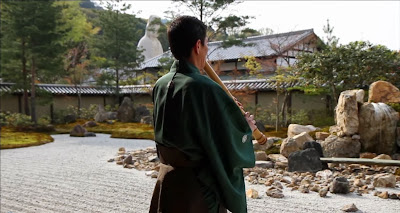Sunday, December 29, 2013
Thursday, December 26, 2013
Icchoken
Icchoken
Icchoken is a name of Fuke sect, Komuso temple which is located in Hakata. During the Kanei era (1624-1643), Ichio from Kyoto, Myoan Temple came down to Hakata and started his Komuso life in Entsu temple which at the time did not have a priest. Since then, Icchoken has become the first Komuso temple in Chikuzen (Northern Kyushu).During the time of Ikku Ⅴ, he asked the domain for an estate in Yaguramon (Gion) and named it “Entsuji Icchoken” which was later renamed “Fumonzan Icchoken.” In the 4th year of the Meiji era (fiscal year 1871), Icchoken could not be spared from the abolishment of Fuke sect. However, Icchoken revived in Daijojimaecho (Reizen) in the 26th year of the Showa era (1951), which was then moved to Saiko Temple in a sub-temple of Rinzaishu Myoshinji sect, Shofukuji.
In the main hall, we have enshrined a statue of the patriarch of Fuke sect “Fukezenji*” and a statue of Komuso “Kusunoki Masakatsu”. Although Fuke sect had vanished from the public, its tradition has been inherited and it has been designated as an intangible cultural heritage of Fukuoka with the name of "Icchoken Denhocchiku" (Komuso's shakuhachi that has been handed down to Icchoken) since the 40th year of Showa.
*zenji ... Zen-master
Fuke sect
Fuke sect is a religion in which the believers play the shakuhachi, a religious instrument, during their religious training. In other words, they believe that playing thoroughly every sound of the shakuhachi makes you reach enlightenment.Their first ancestor was Fukezenji who had a connection with Rinzaizenji during the Tang dynasty of China. Fukezenji's apprentice was charmed by the sound of the bell his master rang at the time for religious meditations, so he recreated the sound with the shakuhachi. That was the beginning of this religion. It was brought to our country by Shinchi kakushin who went to Sung during the Kamakura Period. “Kyotakudenkikokujikai” (Fuke sect's origin that was written during the Edo period)
Komuso
Komuso means Fuke-Buddhists who play shakuhachi at the time of religious mendicancy. Kusunoki Masashige, a warlord who was active during the period of the Southern and Northern courts, had a grandson named Kusunoki Masakatsu. When he was in Sung he played the shakuhachi and went on a pligrimage by the name of “Komu” which is responsible for the name “Komuso”. Another origin could be “Komoso” who wrapped a mat woven with rush around their waist during religious mendicancy and their name has gradually been changed. Apparently they were also called “Boronji,” “Boroboro,” “Boro”.In the Edo period, Fuke sect was established well and Komuso started to provide three items (Shakuhachi, Kesa, Tengai) and three signatures (Honsoku, Kaiin, Tsuin). Komuso are people that have escaped from the world and have become Anchorets, so they considered each other as brothers. When they crossed the world of dust they were given a tengai, a deeply woven straw hat in order to avoid getting dust in their eyes from the wind. Tengai has woven windows called Doko (pupil) so that they can see the outside world easily, but apparently, tengai of Icchoken's Komuso did not have Doko until the Meiji Restoration.
Three signatures include Honsoku, a document of fundamental dogma, Kaiin, a certificate of being a Fuke-Buddhist, and Tsuin, a passport that allows you to go on a pilgrimage. When Komuso met each other, it was a rule to show those three signatures to distinguish fake Komuso. Also, keeping their tengai on was a manner during the religious mendicancy no matter how royal people visited. It was considered rude to show their face. Although Komuso disappeared due to the abolishment of Fuke sect in the 4th year of Meiji, religious mendicancy of Komuso has revived after Komusodera (temple with Komuso) gained formal acceptance as a religious corporation in Showa.
Wednesday, December 25, 2013
Monday, December 9, 2013
Miura Kindo Shakuhachi
Sunday, December 8, 2013
Sunday, November 24, 2013
Shakuhachi for Lincoln
Morimasa Horiuchi plays a 1.8 red cedar Shin-Sei travel shakuhachi for Abraham Lincoln on the 150th anniversary of the Gettysburg Address in Springfield, Illinois.
Saturday, November 23, 2013
Fuan #40
Monday, November 11, 2013
Saturday, October 26, 2013
Saturday, October 5, 2013
http://www.youtube.com/watch?v=V04tWKrHUQ0
http://www.youtube.com/watch?v=8iIR0Ydj5PU
http://www.youtube.com/watch?v=8iIR0Ydj5PU
 |
| old soul, young heart for eternity |
Sunday, June 30, 2013
The Black Resin Jinashi Shakuhachi
 | |
|
Subscribe to:
Comments (Atom)







.jpg)
.jpg)






































